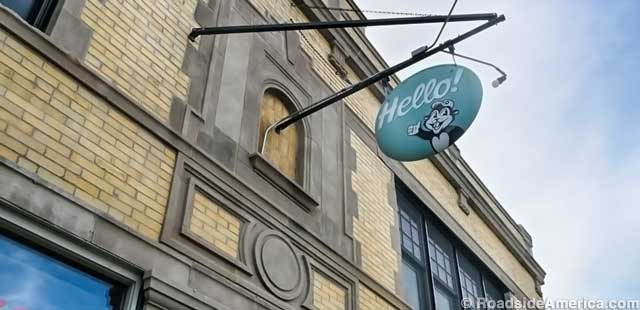
The world's largest button is correctly sized to accessorize the Statue of Liberty.
Busy Beaver Button Museum
Chicago, Illinois
The circular sign hanging over the entrance to the Busy Beaver Button Company and Museum is in fact a very large pin-back button -- the largest in the world, according to Christen and Joel Carter, Busy Beaver's sister/brother owner/curators. The button, they told us, is not randomly big: it's scaled to the size that a standard one-and-a-quarter-inch button would be if it was worn by the Statue of Liberty.
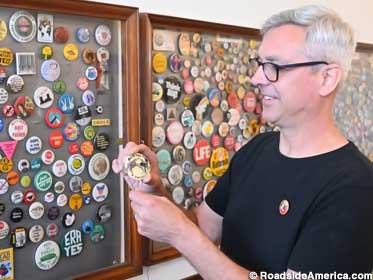
Joel Carter pulls a string, and a donkey kicks an elephant.
Busy Beaver began making buttons in 1995 and opened its museum in 2010. The company, said Joel, cranks out four to five million every year, and has created roughly 150,000 different message-and-art buttons. Yet only three or four of Busy Beaver's own creations are displayed in the 3,500-button museum. That, said Christen, shows the long and diverse history of buttons as a form of communication.
"It's all about expressing yourself," said Christen, and the buttons in the museum broadcast proclamations on a limitless range of topics, from the historic (Impeach Nixon) to the obscure (My Cement Block Helped Build Hubbard Lake Fire Hall). "That's one of the cool things about them."
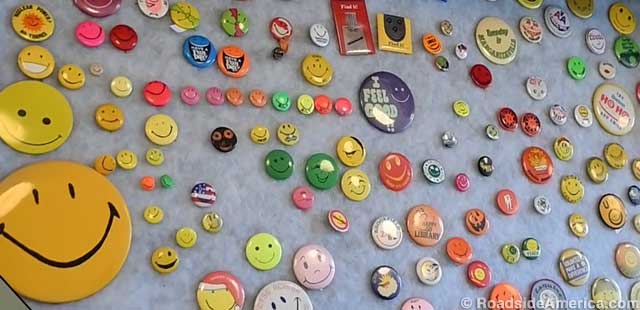
The 1970s was a decade of smiles -- on buttons.
The cool pin-backed button, however, is not without controversy. The 1999 film "Office Space," for example, showed the false use of buttons, as mere "flair" on the uniforms of customer service workers, an abuse that Christen said has tarnished buttons' reputation for honest expression. Joel said that the Button Museum has placed a fake flair button in its collection -- it has a subtle subversive message -- "to see if people are paying attention."
Another controversy involves the word "button." Some people believe that the correct word for these little metal placards is "pin." Christen said that history favors "button" because the first collectable button (1789) mimicked the customized buttons on George Washington's coat, and the modern pin-button's patent (1896) calls them "buttons." But confusion still exists, and visitors do sometimes enter the Button Museum expecting to see the other kind of button. "There's a button store nearby that sells really nice clothing buttons," said Christen, "so we send them there."
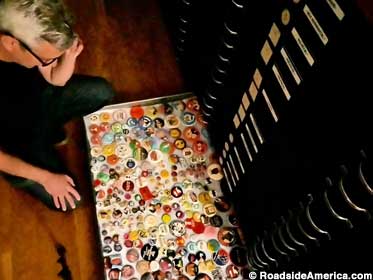
Thousands of examples fill the museum's flat files.
The museum takes up only a small part of the Busy Beaver Button building, yet it has -- as far as Christen and Joel can tell -- the largest public display of buttons anywhere. Tourists are greeted at the door by an employee who relates the history of pin-back buttons and explains how the buttons are organized; then museum-goers are free to explore at their leisure. The framed wall displays and flat files are broadly categorized: "Music," "Cause," "Television," "Beer," "Beavers." Some button-friendly trends -- smile buttons and streaking buttons and "I Heart" buttons -- have their own sections. "Visitors will read out loud certain buttons that maybe they remember," said Christen. She and Joel were delighted when one recognized a button (Dance Your Ass Off) that he had personally designed in 1975.
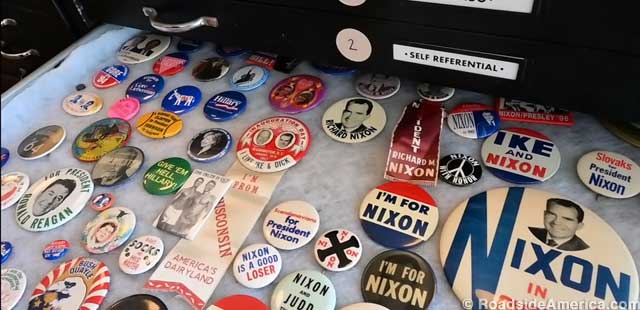
If buttons were votes, Nixon would never lose.
Unlike an opinion safely shouted from a keypad or a bumper sticker, a button requires physical proximity. "The thing about a button is that you really have to stand behind it, literally," said Christen. "When someone asks, 'What does that button mean?' then the button is doing its job." Yet some of the museum's vintage conversation-starter buttons were probably less successful than others. One can imagine a woman in the 1970s reading a prospective suitor's Let's Get V.D. or Women Should Be Obscene And Not Heard button and saying, "Yeah, you're real funny." And other buttons, in what we called the Sullen Teenager category, seemed designed to turn people away. I'm Surrounded By Idiots. I'm Not Deaf I'm Ignoring You.
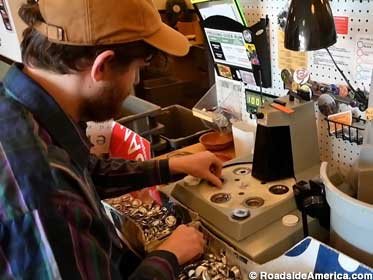
The button factory: always busy at Busy Beaver.
The factory room of Busy Beaver is usually closed to the public -- Joel said that some of their clients want their buttons kept secret until they're released -- but visitors are welcome to make their own buttons on a small machine in the museum. Unlike the Bobblehead Museum in Milwaukee, which disfavors "vanity" bobbleheads over those meant for mass distribution, the Button Museum welcomes, and even displays, limited-run or one-of-a-kind buttons if Christen and Joel think that they're interesting enough. "It's about the expression," said Christen, even though obscure declarations such as I Helped Bring Jessie Fuller To Capitola and I Am A Lehmann Courts Nautilust can frustrate the museum's diligent efforts to decipher them.
Christen and Joel feel that buttons are significant markers of history -- "a people's history," as Christen calls it -- yet the transitory nature of what they celebrate is often humbling. "A lot of things have been lost to time," admitted Christen, and if that time was your time then it can seem jarring and unfair. "Some of our younger workers wanted to know what Who Shot J.R.? meant," said Joel. "One of our research interns didn't know what Gilligan's Island was," said Christen, who views such disconnects cheerfully. "It's cool because I think a lot of the people who come here learn stuff."
There's no current shortage of people willing to make their opinions known, and we wondered if the personal-space messaging role of buttons had been overtaken in recent years by t-shirts and baseball caps. Joel and Christen said no; all three can coexist, and Busy Beaver button sales certainly suggest that this is true.
"There's room for everyone; people can still wear buttons on their t-shirts and hats," said Joel. Christen added, "I think they can be friends."





